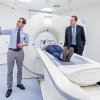
Siemens received FDA clearance for its SOMATOM Force dual source CT scanner. Originally introduced last year at the RSNA in Chicago, the scanner has the fastest acquisition time of any similar device, allowing chest and abdomen scans in under a second without breath holding and cardiac imaging within a heartbeat. It also features capabilities for low-dose scanning with resolutions previously unavailable, allowing for imaging of patients even with reduced renal function.
Lung scans can be performed at radiation doses half of what similar similar systems are able to do today thanks to spectral filters, called Selective Photon Shields, that “optimize the X-ray spectrum to improve the air/soft-tissue contrast (0.1 mSv for a lung scan should be possible according to preliminary studies),” according to our previous coverage.
For years, CT imagers have been investigating the usage of different energy levels (kilovoltage or “kV”) to elicit an enhanced contrast-to-noise ratio and lower patient radiation dose. Lowering kV levels also can potentially increase enhancement of contrast medium, so less contrast may be necessary. This practice had limitations because earlier generations of CT scanners could not sufficiently power imaging at very low kV levels except when imaging children or very small adults. In early investigational research with the SOMATOM Force, radiologists have observed low, previously unachievable kV imaging results that are enabled by the Force’s power reserves.
“The massively enhanced tube power of the SOMATOM Force enables imaging that can be acquired at very low kV settings — and thus at a lower level of radiation dose — routinely in adult patients and even those of a larger body type. In the past, these low kV settings would have resulted in noisy, nondiagnostic studies,” said Joseph Schoepf, MD, director of CT research and development and professor of radiology and cardiology at Medical University of South Carolina.
Due to its low kV imaging, the SOMATOM Force broadens CT’s application for patients with renal insufficiency. While necessary for conventional CT imaging, iodine contrast medium can place a burden on the kidneys, especially for older patients or those with chronic kidney disease. Previously, clinicians had two options: scan without contrast or avoid scanning entirely. The SOMATOM Force extends CT’s use for these patients, especially in urgent situations when they can most benefit.
An author of numerous published studies on the benefits of low kV imaging and an internationally recognized expert in neuroradiology, Lawrence N. Tanenbaum, MD, FACR, noted, “The SOMATOM Force enables routine 70 kV imaging — a technique poised to make a tremendous impact in day-to-day scanning of adult and pediatric patients, with benefits such as decreased radiation dose and impressive time-resolved imaging.”
Source:Siemens
SIEMENS SOMATOM FORCE DUAL SOURCE CT SCANNER

